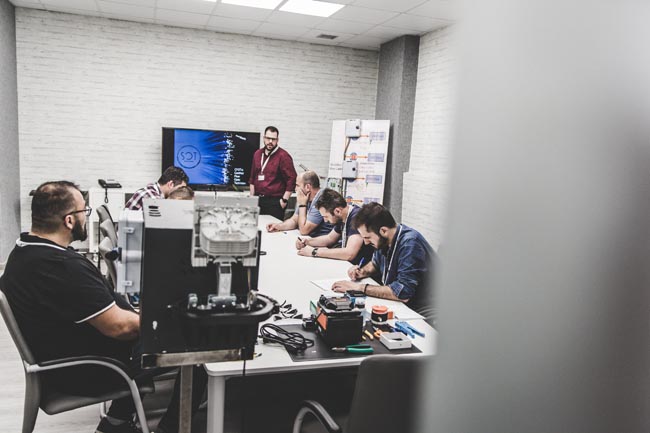Certified Fiber Optic Technician
| Certification | Instructor: P. Gkoumas | Duration 3 Days |
BOOK NOW + |
|---|---|---|---|
Description
CFOT® – Certified Fiber Optic Technician – is the primary FOA certification for all fiber optics applications. CFOTs have appropriate knowledge, skills and abilities (KSAs) in fiber optics that can be applied to almost any job – design, installation, operation – for almost any application – outside plant, premises, manufacturing, etc.
FOA CFOT certification is based on an extensive knowledge of fiber optics technology and application as well as demonstrated skills in appropriate tasks. Most CFOTs work in the industry as contractors or installers. Consultants, network designers, estimators and trainers would also be expected to have such credentials. CFOTs are also involved with the manufacture of fiber optic components such as cables, patchcords, active devices and communications systems.
However, the CFOT certification has been structured as a general technology certification, not aligned to any specific job function. It is used by all installers, both outside plant and premises installers, two very different applications, plus component manufacturing technicians, network managers, network designers, etc. A well-prepared fiber optic technician will have a CFOT plus appropriate specialist certifications (CFOS) for the skills needed for the job (OSP, spicing, connectors, testing, design, etc.) and applications (FTTH, OLAN, Wireless, etc.).
Contents - Coverage DOWNLOAD PDF +
Objectives: From this lesson you should learn:
What does “fiber optics” mean
How fiber was developed and used in communications
The difference between “outside plant” and “premises” fiber optics
Some advantages of fiber optics
What standards cover fiber optics
How to work with fiber safely
Objectives: From this lesson you should learn:
The language of fiber optics
Systems of measurements used in fiber optics
Specialized fiber optic terms
The key to understanding any technology is understanding the language of the technology – the jargon. We’ve started the website and book with an overview of fiber jargon to introduce you to the language of fiber optics and help you understand what you will be reading in the lessons. We suggest you read this section first to help your understanding of the rest of the course and refer back to it when you encounter a term that you do not recognize.
Objectives: From this lesson you should learn:
The advantages of optical fiber as a communications medium
How optical fiber is used in communications systems
Other uses for fiber optics
Why use fiber?
Fiber has become the communications medium of choice for telephones, cell phones, CATV, LAN backbones, security cameras, industrial networks, just about every kind of communications – now even all the way to the home. In this lesson, you will learn why fiber is the medium of choice for most communications networks and how many of those networks use fiber.
Objectives: From this lesson you should learn:
How fiber optic data links and transmission systems work
What components are used in transceivers
Types of sources and detectors used in transceivers
Performance parameters of fiber optic transmission systems
Fiber optic transmission systems use datalinks that consists of a transmitter on one end of a fiber and a receiver on the other end. Most systems operate by transmitting in one direction on one fiber and in the reverse direction on another fiber for full duplex operation. A FTTH passive optical network (PON) is one of the few systems using bidirectional transmission over a single fiber because its network architecture is based around couplers already. Datalinks can be analog or digital, depending on the information being transmitted.
In this lesson you will learn how fiber optic systems transmit data.
Objectives: From this lesson you should learn:
The types of fiber optic cables and their applications
Differences between outside plant and premises cables
Specifications for fiber optic cables
Fiber Optic Cable Design
This lesson covers cables. Fiber optic cable provides protection for the optical fiber or fibers within it appropriate for the environment in which it is to be installed. Cable refers to the complete assembly of fibers, strength members and jacket. Fiber optic cables come in many different types, depending on the number of fibers and how and where it will be installed. It is important to choose cable carefully as the choice will affect how easy the cable is to install, splice or terminate, what it will cost and how long it will last in the field.
The tutorial is a short presentation on fiber types and their applications. The Hands-On presentation shows how types of fiber cable are prepared for installation and splicing or termination.
Objectives: From this lesson you should learn:
The difference between connectors and splices
Requirements for connectors and splices
Connector styles
Termination types of connectors
Splice types
Splicing procedures
Connectors or Splices?
In this lesson, a long and very important one, you will learn about fiber splicing and termination. Fiber optic joints or terminations are made two ways: 1) connectors that mate two fibers to create a temporary joint, patch between two cables and/or connect the fiber to a piece of network gear or 2) splices which create a permanent joint between the two fibers.
Either termination method must have two primary characteristics: good optical performance indicated by low loss minimal reflectance and high reliability. Terminations must also be of the right style to be compatible to the equipment involved and be protected against the environment in which they are installed.
Objectives: From this lesson you should learn:
What is involved in a fiber optic installation
The role of the contractor and installer
How to prepare for the installation
What is involved in the installation process
How to verify the quality of the installation
Safety for fiber optic installations
This lesson covers fiber optic installation. After the process of designing fiber optic networks is completed, the next step is to install it. What do we mean by the “installation process?” Assuming the design is completed, we’re looking at the process of physically installing and completing the network, turning the design into an operating system.
Objectives: From this lesson you should learn:
What parameters need to be tested
What instruments are used for fiber optic testing
How to perform basic fiber optic testing
Measurement uncertainty in fiber optic testing
How to troubleshoot problems
Fiber Optic Tests
This lesson, another extensive one, is on fiber optic testing. Testing is the most complex part of fiber optics but one of the most important.
Objectives: From this lesson you should learn:
What Is Fiber Optic Network Design?
What is involved in fiber optic network design
What a designer needs to know
How a project develops from idea to installation
How to choose equipment and components for the network
How to create a loss budget for the design
How to plan for and complete an installation
This lesson will help you learn the process of designing a fiber optic network. Not everyone will design a fiber optic network, but understanding the process will make installing, testing and documenting a network easier.







